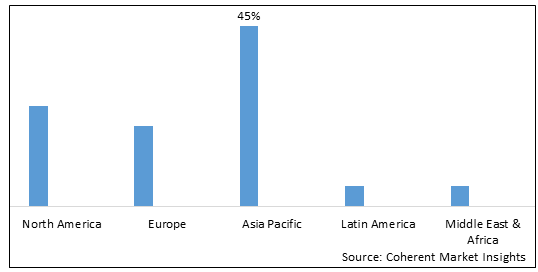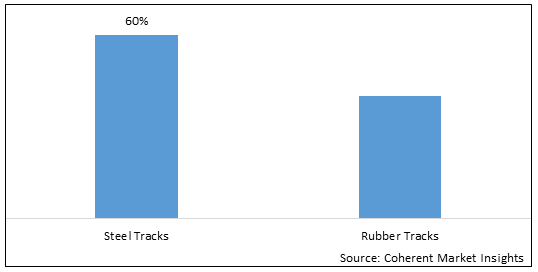Steel Tracks and Rubber Tracks Market is estimated to be valued at USD 2.44 Bn in 2025 and is expected to reach USD 3.89 Bn in 2032, exhibiting a compound annual growth rate (CAGR) of 6.9% from 2025 to 2032.
Steel tracks and rubber tracks are two essential components in the construction equipment and heavy machinery industry. Both types of tracks serve the purpose of providing traction, stability, and durability for various machines, such as excavators, bulldozers, skid steers, and compact track loaders.
Steel tracks are known for their robustness and longevity, making them suitable for applications in harsh and challenging terrains like rocky surfaces and rugged landscapes. They offer superior weight-bearing capabilities and are less susceptible to damage from sharp objects, making them ideal for heavy-duty tasks. However, they can be less forgiving on sensitive surfaces and may cause more ground damage compared to their rubber counterparts.
On the other hand, rubber tracks have gained popularity for their versatility and reduced ground impact. They offer greater flexibility and a smoother ride, which translates to improved maneuverability and traction on delicate surfaces like asphalt and concrete. Rubber Tracks are also quieter during operation and generally require less maintenance compared to steel tracks.
Steel Tracks and Rubber Tracks Market Regional Insights
Figure 1. Global Steel Tracks and Rubber Tracks Market Share (%), by Region, 2025

To learn more about this report, Download Free Sample
Steel Tracks and Rubber Tracks Market Drivers:
For Instance: According to India Brand Equity Foundation India is expected to become the third-largest construction market globally by 2022. The country plans to spend $1.4 trillion on infrastructure development between 2019 and 2023
For Instance: United Nations data reveals that China is anticipated to invest a staggering $12 trillion solely in new infrastructure projects by 2025. This massive investment is geared towards supporting China's rapid urban transition, with a vision for over 70% of its population residing in cities.
Steel Tracks and Rubber Tracks Market Opportunities:
For Instance: In 2020, the EIB approved €63.3 billion of financing for projects, out of which €13.1 billion was for infrastructure projects
For Instance: In Jan 2023, According to PIB Delhi India's agriculture sector has been experiencing strong growth, boasting an impressive average annual growth rate of 4.6% over the past six years.
Steel Tracks and Rubber Tracks Market Trends:
For Instance: According to statistics released by the European Construction Equipment Federation in 2022, an excavator equipped with rubber tracks demonstrates a 12% higher lifetime fuel efficiency compared to the same excavator with steel tracks.
For Instance: In a 2023 research report published by the US Army Engineering Research and Development Center, findings indicated that 3D printed tracks exhibited equivalent or even superior wear resistance compared to traditional tracks made of rubber or steel.
Steel Tracks and Rubber Tracks Market Report Coverage
| Report Coverage | Details | ||
|---|---|---|---|
| Base Year: | 2024 | Market Size in 2025: | USD 2.44 Bn |
| Historical Data for: | 2020 To 2024 | Forecast Period: | 2025 To 2032 |
| Forecast Period 2025 to 2032 CAGR: | 6.9% | 2032 Value Projection: | USD 3.89 Bn |
| Geographies covered: |
|
||
| Segments covered: |
|
||
| Companies covered: |
Bridgestone Corporation, Camso Ltd. (formerly known as Camoplast Solideal), Bridgestone Industrial Products America, Inc., Continental AG, Titan International, Inc., Mattracks, Inc., Global Track Warehouse USA, VMT International, Trelleborg AB, McLanahan Corporation, Superior Tire & Rubber Corp., TFI Tracks, CTS Tire Express, Eurotrack Ltd., and TuffStuff Australia |
||
| Growth Drivers: |
|
||
| Restraints & Challenges: |
|
||
Uncover macros and micros vetted on 75+ parameters: Get instant access to report
Steel Tracks and Rubber Tracks Market Restraints:
Counterbalance: Both steel and rubber tracks are known for their durability. Steel tracks, in particular, are extremely tough and can handle very harsh conditions, which means they don't need to be replaced as often. Rubber tracks, while less durable than steel, require less maintenance, which can lead to cost savings over time.
Counterbalance: Despite the high maintenance and replacement costs, the use of steel and rubber tracks can lead to significant cost savings in other areas, such as fuel efficiency and increased productivity, which can offset these costs.
Recent Developments
New product launches
Key Strategic Initiatives
Acquisition and partnerships
Figure 2. Global Steel Tracks and Rubber Tracks Market Share (%), by Track Type, 2025

To learn more about this report, Download Free Sample
Top Companies in Steel Tracks and Rubber Tracks Market
Definition: Steel tracks and rubber tracks are types of traction systems used in heavy machinery and construction equipment. Steel tracks are made of steel components and are known for their durability and strength, making them suitable for demanding terrains and heavy-duty applications. Rubber tracks, on the other hand, are composed of rubber and other composite materials, offering reduced ground impact, improved maneuverability, and versatility, making them ideal for sensitive surfaces and urban construction projects.
Share
Share
About Author
Ramprasad Bhute is a Senior Research Consultant with over 6 years of experience in market research and business consulting. He manages consulting and market research projects centered on go-to-market strategy, opportunity analysis, competitive landscape, and market size estimation and forecasting. He also advises clients on identifying and targeting absolute opportunities to penetrate untapped markets.
Missing comfort of reading report in your local language? Find your preferred language :
Transform your Strategy with Exclusive Trending Reports :
Frequently Asked Questions
Select a License Type
Joining thousands of companies around the world committed to making the Excellent Business Solutions.
View All Our Clients